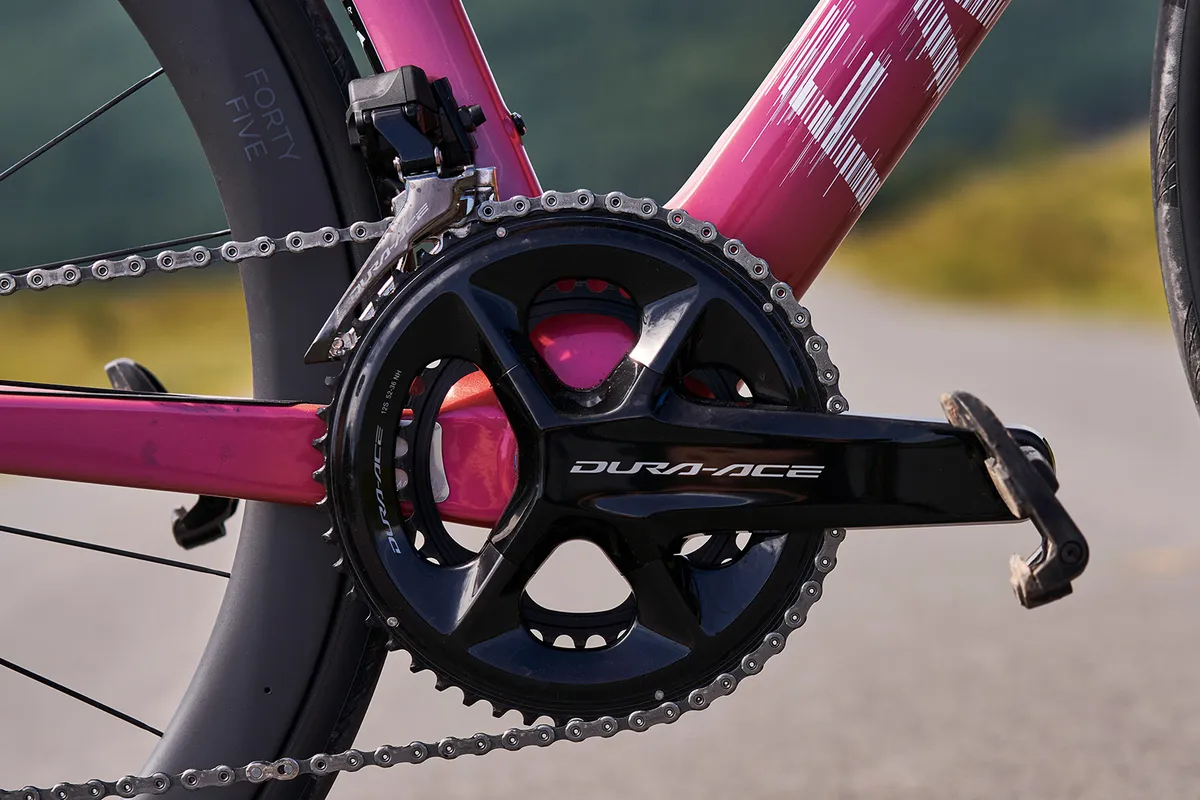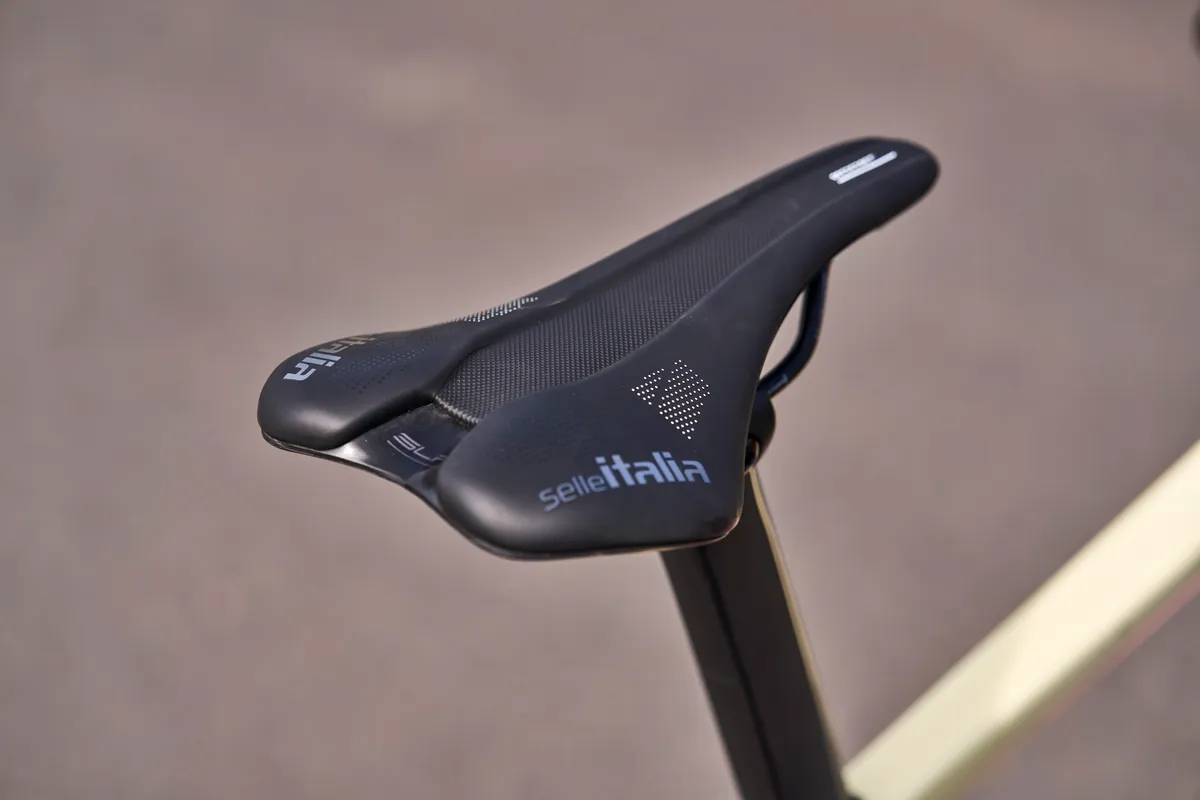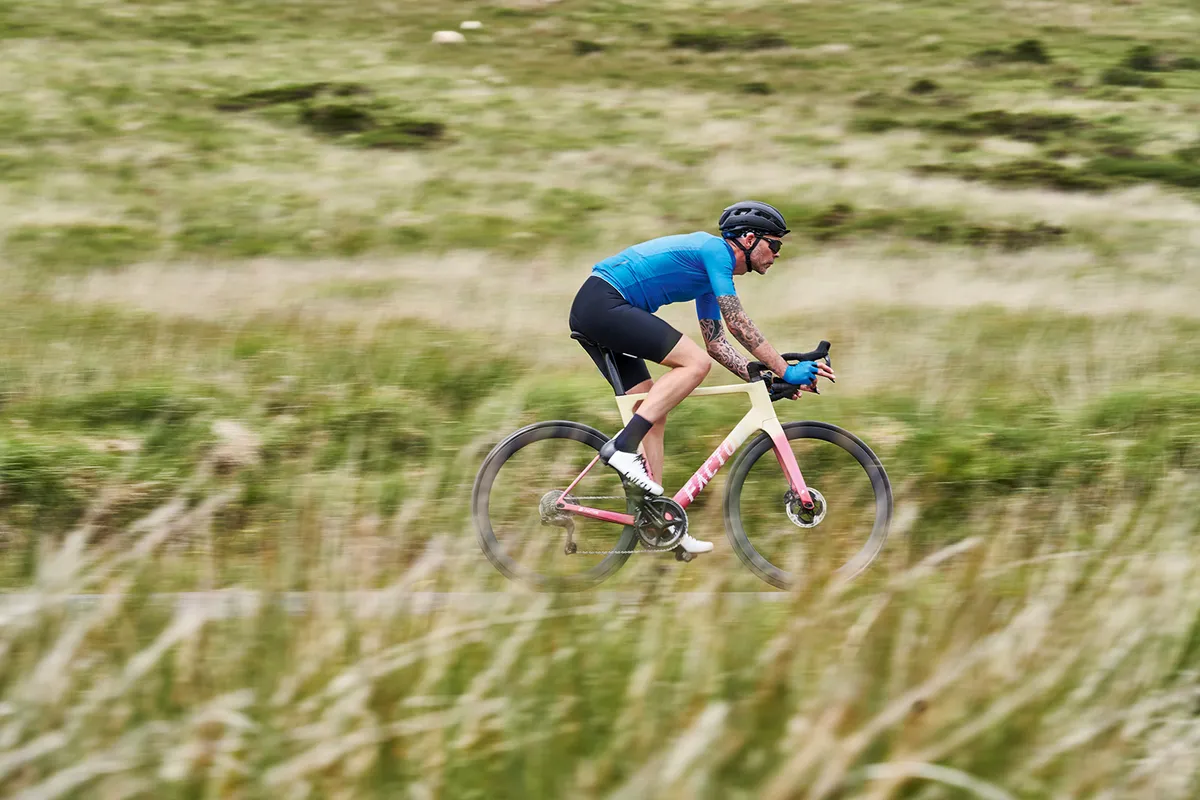The Factor Ostro VAM is an all-round road bike that's intended to strike an ideal balance between aerodynamic efficiency, comfort and low weight.
Said to be a 'quiver-killer' (meaning it’s one bike to do the job of many), the Ostro VAM is something of a Frankenstein bike, spliced together from the front half of an aero road bike, the rear end of a climbing bike and the tyre clearance of an endurance road bike.
At £5,200 for the frameset, integrated handlebar and small parts (£9,450 as specced for this review), it has a price tag that pits it against some of the best road bikes available.
If you can stomach the price, though, the Ostro VAM is an exciting road bike that excels in almost every area.
- Frameset price: £5,200 / $5,499
One bike to rule them all

Though a relatively young brand, Factor has a track record of making unusual, cutting-edge bikes.
It burst onto the scene in 2009, in the guise of the BERU f1systems’ Factor001. The Formula 1 inspired bike featured a striking split down tube and fork design, complete with telemetry sensors and ahead-of-its-time features such as hydraulic road disc brakes and an integrated power meter.
Aero road bikes such as the Vis Vires and One followed, as well as special builds such as the 5.1kg O2 Disc Project, which was claimed at the time to be the lightest road bike with disc brakes in the world.
Despite the Ostro VAM still cutting something of a distinctive figure compared to competitors such as the Specialized S-Works Tarmac SL7, Scott Foil and Pinarello Dogma F, it’s a bike that has gravitated more towards the mainstream.
Designed by a team led by Factor’s director of engineering, Graham Shrive (previously of Cérvelo), the Ostro VAM frameset is said to be significantly more aerodynamic than the O2 VAM (Factor’s dedicated lightweight road bike), yet only around 100g heavier.

To put a number on it, Factor claims 830g for a size 54 with the Flicker paintjob.
Equipped with a Shimano Dura-Ace Di2 R9200 groupset and a slew of high-end parts, my test bike weighs 7.41kg.
That’s impressively lightweight considering the ‘Sicilian Peach’ (or ‘rhubarb and custard’, as the BikeRadar team dubbed it) paintjob is likely adding a couple of hundred grams to the frameset.

Up front, the fork has an unusually wide stance. This is said to reduce turbulence caused by the rotation of the front-wheel spokes, reducing aerodynamic drag.
It also enables clearance for up to 32c tyres on rims with a 21mm internal width. Combined with the slimmed-down rear end, it means the Ostro VAM is a race bike that can handle itself on broken roads too.
Factor Ostro VAM geometry and ride feel

In terms of the riding position and handling, the Ostro VAM sits in classic race bike territory.
As regards stack and reach, it’s almost identical to the Giant TCR Advanced Pro Disc, at 565mm and 392mm respectively (a M/L Giant TCR is 562mm and 393mm).
That’s a little shorter and higher than the Specialized Tarmac SL7, though that’s a noticeably aggressive bike.
Achieving a long and low, aerodynamic riding position poses no problems, then, but it’s also possible to run a few spacers under the stem for a marginally more relaxed fit.
With its 73.3-degree head tube angle and 57.5mm of trail, the handling is responsive, but not quite as lightning-quick as the Specialized Tarmac (73.5-degree head tube angle and 55m of trail).
Overall, the Ostro VAM feels composed and confidence-inspiring. Its steering is fast enough to make last-minute corrections when needed, but it’s still stable and predictable at high speeds.
| | 49 | 52 | 54 | 56 | 58 | 61 |
|---|---|---|---|---|---|---|
| Seat angle (degrees) | 74.5 | 74 | 73 | 73 | 73 | 73 |
| Head angle (degrees) | 71.7 | 72.5 | 72.5 | 73.3 | 73.3 | 73.3 |
| Front center (mm) | 574 | 575 | 587 | 591 | 607 | 622 |
| Seat tube (mm) | 456 | 480 | 502 | 525 | 548 | 570 |
| Top tube (mm) | 511 | 527 | 550 | 566 | 582 | 597 |
| Fork offset (mm) | 53 | 48 | 48 | 43 | 43 | 43 |
| Trail (mm) | 57.1 | 57.3 | 57.3 | 57.5 | 57.5 | 57.5 |
| Bottom bracket drop (mm) | 72 | 72 | 70 | 70 | 70 | 70 |
| Wheelbase (mm) | 968 | 968 | 982 | 985 | 1,005 | 1,023 |
| Stack (mm) | 503 | 523 | 542 | 565 | 587 | 611 |
| Reach (mm) | 370 | 376 | 384 | 392 | 401 | 409 |
Though my willowy frame is never going to be the best judge of a bike’s stiffness, the Ostro VAM is snappy and responsive under hard efforts, with no detectable flex or twisting under load.
Despite that, it’s impressively comfortable over rough terrain, and doesn’t leave you feeling sore after a day out on broken back roads.
Factor Ostro VAM finishing kit

Given the lofty price tag (£9,450 for this build, as already mentioned), my test bike features a best-of-the-best build.
While the latest Shimano Ultegra Di2 R8170 groupset effectively matches the performance of Dura-Ace, those who want the lightest possible build will still be well served by Shimano’s top-of-the-range offering, which is around 400g lighter.
Shifting is as slick, fast and reliable as you’d expect from Dura-Ace and the improvements to braking performance are welcome too.
Increased pad clearance (up by 10 per cent versus Dura-Ace Di2 R9170), new rotors and the addition of Shimano’s Servowave technology to the levers has improved braking feel and reduced the occurrence of annoying noises compared to the previous-generation brakes (which were, it should be noted, already very good).

The carbon seatpost is Factor's own, while the integrated handlebar and wheelset are by Black Inc, Factor’s wheel and component brand.
CeramicSpeed supplies the headset and bottom bracket (the Ostro VAM uses a T47 bottom bracket, which is an oversized threaded system).
I opted for a zero-setback seatpost and a 120mm stem, but these components can be customised at the point of purchase to optimise your fit, as can the paintjob, wheelset choice, crank length and gearing.
Overall, it’s a similar level of customisation to that offered by Orbea’s MyO programme and Ribble’s BikeBuilder. As with those, it makes speccing up your dream bike incredibly easy (and sorely tempting).
Other than the zero-offset option, the seatpost is available with 25mm setback and the integrated handlebar in 19 sizes, with bar widths from 380 to 440mm and stem lengths from 90 to 130mm.

While that size range should cover the vast majority of riders, Factor says those who prefer a road handlebar with a different shape can still swap the integrated setup for any stem that uses a standard 1 1/8in steerer clamp.
That’s a relief, too, because I didn’t get on with the shape of the drops. The compact bend sweeps rapidly away from the brake levers, which made it tricky for me to reach the brake levers while in the drops (even after I’d adjusted the lever reach).
Those with larger hands or longer fingers than mine likely won’t experience the same issue, but it’s worth checking before you settle on a front-end setup, because being able to effectively use the brakes from the drops is crucial for safety.
Beyond that specific point, though, it’s a classy-looking piece of kit, which performs very well. The tops are flattened for an aerodynamic gain, but not so aggressively that they’re uncomfortable to hold, and it does a good job of dissipating road buzz.

The Black Inc Forty Five wheels have, as the name implies, 45mm-deep carbon rims laced to Black Inc hubs using Sapim aero spokes.
The tubeless-ready rims have a 21mm internal width and a 27mm external width, optimised for use with 700 x 25c and 700 x 28c tyres.
The claimed weight for the wheelset is competitive, at 1,489g, and the hub bearings are from CeramicSpeed. Like most ceramic bearings, these are claimed to offer reduced friction and improved longevity versus steel bearings, but you pay a premium for them (the price for the wheelset alone is £1,833.33 / $2,399).
On the road, the Black Inc wheels perform excellently, with a taut, responsive feel and no hint of handling issues on windy days.
This is helped by the inclusion of Continental’s GP5000S TR tyres – one of the best road bike tyres currently available – in a 700 x 28c size. They’re light, grippy and fast, and offer an impressive level of puncture protection for such a racey tyre.

To nitpick, while the Selle Italia SLR Boost TM saddle proved comfortable throughout testing, it would be reasonable to expect a saddle with carbon rails at this price.
It’s fair to say the lack of carbon rails doesn’t affect performance (it simply adds a few grams to the overall weight of the bike), and many riders might look to swap in their preferred saddle anyway. But still, the relatively cheap saddle feels slightly out of place on this build.

The seatpost clamping bolt (which is located on the inside of the frame, on the small compensation triangle between the seat tube and top tube) is also angled in such a way that tightening it requires a couple of non-standard attachments for a torque wrench, in order to avoid damaging the frame (because the base of standard bits can rub the upper part of the bolt hole).
The two bits (a 3/8in square socket adaptor and an extended 4mm hex bit) aren’t expensive or difficult to acquire, and once you have them this problem is effectively solved, but given their importance it’s mildly annoying Factor doesn’t supply them with the bike.
Ideally, though, I’d prefer the bolt to be angled such that standard tools can be used without damaging anything.
Factor Ostro VAM bottom line

Factor pitches the Ostro VAM as one bike to do it all, and while you might think twice about taking such an expensive road bike off-road there’s little else it doesn’t excel at.
It’s more conformist than some of Factor’s previous bikes and could be argued to lack the same sense of innovation and flair, but it is undoubtedly as light, fast and comfortable as promised.
Niggles aside, the only major downside is that – like many of its competitors – the Ostro VAM doesn’t come cheap.
It’s far from the most expensive bike in its category, though, and with its excellent build and collection of top-spec, customisable parts and components, it's at least clear where your money has been spent.
How we tested
Whether you’ve pinned on a number or are just trying to beat your mates to the café, the breakaway is a staple of almost every race.
To turn the odds in your favour, you need a bike to suit the task. Something aerodynamic and efficient. Nothing too heavy, so you don’t waste energy on the climbs. Comfortable enough for a long day in the saddle, but with lightning-quick reactions for searing attacks at the finish.
In this test, we pitted three leading all-rounder road bikes with an aero bent to see which provides the best mix of all-round performance when you need to turn on the taps.
Our testing involved longer rides on the rolling terrain of the Mendips. We took in lots of climbing and descending, as well as both good and bad roads, to see where each bike excelled and where they reached their limits.
Putting each bike through its paces back-to-back enabled us to tease out the differences in ride quality and handling, while we also considered how easy each bike is to adapt to your preferred bike fit – an important detail too often overlooked in favour of small gains in the wind tunnel.
- BMC Timemachine Road 01 Three
- Cube Litening C:68X SL
- Factor Ostro VAM
Product
| Brand | factor |
| Price | 9450.00 GBP |
| Weight | 7.4100, KILOGRAM (56cm) - with Black Inc out-front mount |
Features
| Fork | Factor Ostro VAM |
| br_stem | Black Inc Integrated Barstem |
| br_chain | Shimano Dura-Ace R9200, 12-speed |
| br_frame | Factor Ostro VAM |
| Tyres | Continental GP5000S TR, 700 x 28c |
| br_brakes | Shimano Dura-Ace R9200 |
| br_cranks | Shimano Dura-Ace R9200, 52/36T |
| br_saddle | Selle Italia SLR Boost TM |
| br_wheels | Black Inc Forty Five (with CeramicSpeed bearings) |
| br_shifter | Shimano Dura-Ace Di2 R9270 |
| br_cassette | Shimano Dura-Ace R9200, 11-30T |
| br_seatpost | Factor Ostro VAM |
| br_handlebar | Black Inc Integrated Barstem |
| br_bottomBracket | T47, CeramicSpeed bearings |
| br_availableSizes | 49, 52, 54, 56, 58, 61cm |
| br_rearDerailleur | Shimano Dura-Ace Di2 R9270 |
| br_frontDerailleur | Shimano Dura-Ace Di2 R9270 |

